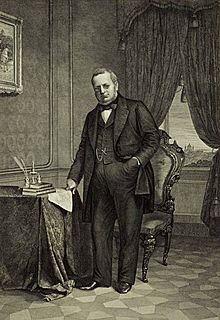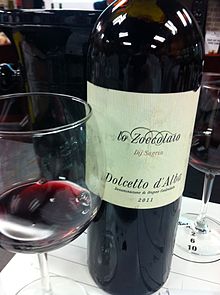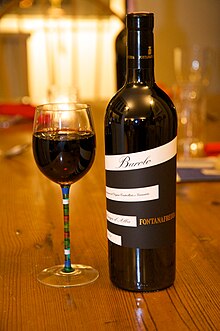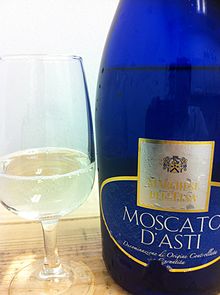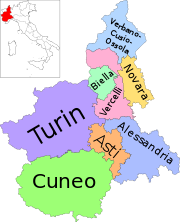
Barolo is a red denominazione di origine controllata e garantita (DOCG) wine produced in the northern Italian region of Piedmont. It is made from the nebbiolo grape and is often described as one of Italy's greatest wines.

Nebbiolo is an Italian red wine grape variety predominantly associated with its native Piedmont region, where it makes the Denominazione di Origine Controllata e Garantita (DOCG) wines of Barolo, Barbaresco, Gattinara, Ghemme, and Roero, together with numerous DOC wines. Nebbiolo is thought to derive its name from the Italian nebbia or Piedmontese nebia, meaning "fog". During harvest, which generally takes place late in October, a deep, intense fog sets into the Langhe region where many Nebbiolo vineyards are located. Alternative explanations refer to the fog-like glaucous veil that forms over the berries as they reach maturity, or that perhaps the name is derived instead from the Italian word nobile, meaning noble. Nebbiolo produces lightly-colored red wines which can be highly tannic in youth with scents of tar and roses. As they age, the wines take on a characteristic brick-orange hue at the rim of the glass and mature to reveal other aromas and flavours such as violets, tar, wild herbs, cherries, raspberries, truffles, tobacco, and prunes. Nebbiolo wines can require years of ageing to balance the tannins with other characteristics.

Barbera is a red Italian wine grape variety that, as of 2000, was the third most-planted red grape variety in Italy. It produces good yields and is known for deep color, full body, low tannins and high levels of acidity.
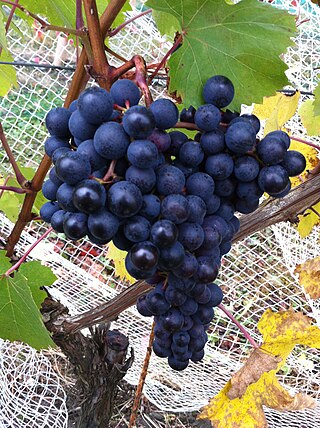
Dolcetto is a black Italian wine grape variety widely grown in the Piedmont region of northwest Italy. The Italian word dolcetto means "little sweet one", but it is not certain that the name originally carried any reference to the grape’s sugar levels: it is possible that it derives from the name of the hills where the vine is cultivated. In any case the wines produced are nearly always dry. They can be tannic and fruity with moderate, or decidedly low, levels of acidity and are typically meant to be consumed within a few years after release.
Grignolino is a red Italian wine grape variety commonly grown in the Piedmont region. It makes light colored wines and rosés with very fruity aromas, strong acidity and tannins. The name Grignolino derives from the word grignole which means "many pips" in the local Piedmontese dialect of the Asti region. The abundance of pips, or seeds, contributes to the strong, bitter tannins associated with the wine. Modern winemakers try to avoid the excess tannins with gentle and slow pressings. Grignolino has three Denominazione di origine controllata (DOCs) that produce wine from it - Asti, Monferrato Casale, and Piemonte Grignolino.

Montferrat is a historical region of Piedmont, in northern Italy. It comprises roughly the modern provinces of Alessandria and Asti. Montferrat is one of the most important wine districts of Italy. It also has a strong literary tradition, including the 18th century Asti-born poet and dramatist Vittorio Alfieri and the Alessandrian Umberto Eco.

The Langhe is a hilly area to the south and east of the river Tanaro in the provinces of Cuneo and Asti in Piedmont, northern Italy.

Italian wine is produced in every region of Italy. Italy is the world's largest wine producer, as well as the country with the widest variety of indigenous grapevine in the world, with an area of 702,000 hectares under vineyard cultivation, and contributing a 2013–2017 annual average of 48.3 million hl of wine. In 2018 Italy accounted for 19 per cent of global production, ahead of France and Spain. Italian wine is both exported around the world and popular domestically among Italians, who consume an average of 42 litres per capita, ranking fifth in world wine consumption.

Asti is a sparkling white Italian wine that is produced throughout southeastern Piedmont, but is particularly focused around the towns of Asti and Alba. Since 1993 the wine has been classified as a denominazione di origine controllata e garantita (DOCG) and as of 2004 was Italy's largest producing appellation. On an average vintage more than ten times as much Asti is produced in Piedmont than the more well-known Piedmontese red wine Barolo.

Barbaresco is an Italian wine made with the Nebbiolo grape. Barbaresco is produced in the Piedmont region in an area of the Langhe immediately to the east of Alba and specifically in the comunes of Barbaresco, Treiso and Neive plus that area of the frazione San Rocco Seno d'Elvio which was once part of the comune of Barbaresco and now belongs to the comune of Alba. It was granted Denominazione di origine controllata (DOC) status in 1966 and Denominazione di Origine Controllata e Garantita status in 1980. The wine is often compared with Barolo—another Nebbiolo-based wine from the Piedmont area. Though the wines do share many similarities, there are some distinct differences between them.

Costigliole d'Asti is a small Italian town in the Province of Asti, southern Piedmont. It lies about 13 kilometres south of the city of Asti in the Alto Monferrato, on the edge of the Langhe, in the alluvial plain of the river Tanaro southwards into the hills. The name derives from the Latin Corte Costeliolae.
Freisa is a red Italian wine grape variety grown in the Piedmont region of north-west Italy, primarily in Monferrato and in the Langhe, but also further north in the provinces of Turin and Biella. Freisa is a vigorous and productive vine whose round, blue-black grapes are harvested in early October. The three-lobed leaves are relatively small and the bunches are elongated in form. By the 1880s it had become one of the major Piedmontese grapes, and in that period its cultivation was stimulated by the vine’s resistance to the downy mildew caused by the Plasmopara viticola fungus. Wines made from the Freisa grape are red and usually somewhat sweet and lightly sparkling, or foaming. Still and fully sparkling versions are also produced, however, as are dry and more decidedly sweet styles. In the Canavese there is also a rosé which can be made primarily from Freisa according to Denominazione di origine controllata (DOC) regulations.

Roero is a geographical area in the north-east corner of the province of Cuneo in Piedmont, north-west Italy. This hilly region is known for its wines and for its fruit production: particularly the peaches of Canale and the local variety of pear known as Madernassa which originated in the late eighteenth century in Vezza d'Alba. Strawberries are also grown.

Lombardy wine is the Italian wine produced in the Lombardy region of north central Italy. The region is known particularly for its sparkling wines made in the Franciacorta and Oltrepò Pavese areas. Lombardy also produces still red, white and rosé wines made from a variety of local and international grapes, including Nebbiolo wines in the Valtellina region and Trebbiano di Lugana white wines produced with the Chiaretto style rosé along the shores of Lake Garda. The wine region currently has 22 denominazione di origine controllata (DOC), 5 denominazione di origine controllata e garantita (DOCG) and at least 13 indicazione geografica tipica (IGT) designations. The main cities of the region are Milan, Bergamo and Brescia. The region annually produces around 1.3 million hectolitres of wine, more than the regions of Friuli-Venezia Giulia, Marche, Trentino-Alto Adige/Südtirol and Umbria.

Arneis is a white Italian wine grape variety originating from Piedmont, Italy. It is most commonly found in the hills of the Roero, northwest of Alba, where it is part of the white Denominazione di Origine Controllata e Garantita (DOCG) wines of Roero. It can also be used to produce DOC wines in Langhe. Arneis is so called because it is regarded as a somewhat difficult variety to grow. It is a crisp and floral varietal, and has been grown for centuries in the region. The white wines made from the Arneis grape tend to be dry and full bodied with notes of pears and apricots.

Gaja is an Italian wine producer from the Piemonte region in the district of Langhe, chiefly producing a number of Barbaresco and Barolo wines, and later diversified into Brunello di Montalcino and "Super Tuscan" production. Its current owner and president Angelo Gaja is credited with developing techniques that have revolutionised winemaking in Italy, and terms such as "the undisputed king of Barbaresco", and "the man who dragged Piedmont into the modern world" have been applied to him, and whose Barbaresco wine is considered a status symbol on a par with Château Lafite Rothschild or Champagne Krug.
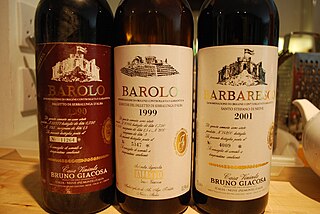
Bruno Giacosa was an Italian wine producer from the village Neive in the Langhe region (Piemonte), who produced a number of Barbaresco and Barolo wines, as well as bottlings of Arneis, Barbera, Dolcetto and a sparkling wine. Wines produced from owned vineyards are bottled under the label Azienda Agricola Falletto , wines from bought grapes or from grapes from leased vineyards under the label Casa Vinicola Bruno Giacosa. In terms of the production of Nebbiolo, Giacosa was considered a traditionalist. He has been described as the "Genius of Neive".

Aldo Conterno was an Italian winemaker of eponymous wine producer Poderi Aldo Conterno from the Piemonte region in the district of Langhe, chiefly producing Barolo wines. The winery is located in Monforte d'Alba, and Conterno was widely ranked among Piemonte's foremost producers.
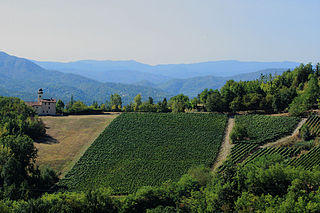
Brachetto d'Acqui is a red Italian wine that is classified as a Denominazione di Origine Controllata e Garantita (DOCG) since 1996 and previously a Denominazione di Origine Controllata (DOC) region since 1969. It is produced in the Piedmont wine region around Acqui Terme in the province of Alessandria with some overlap into the province of Asti. The wine is produced from the Brachetto grape, a variety that is believed to be native to Piedmont, and can be still or sparkling with usually some sweetness.

